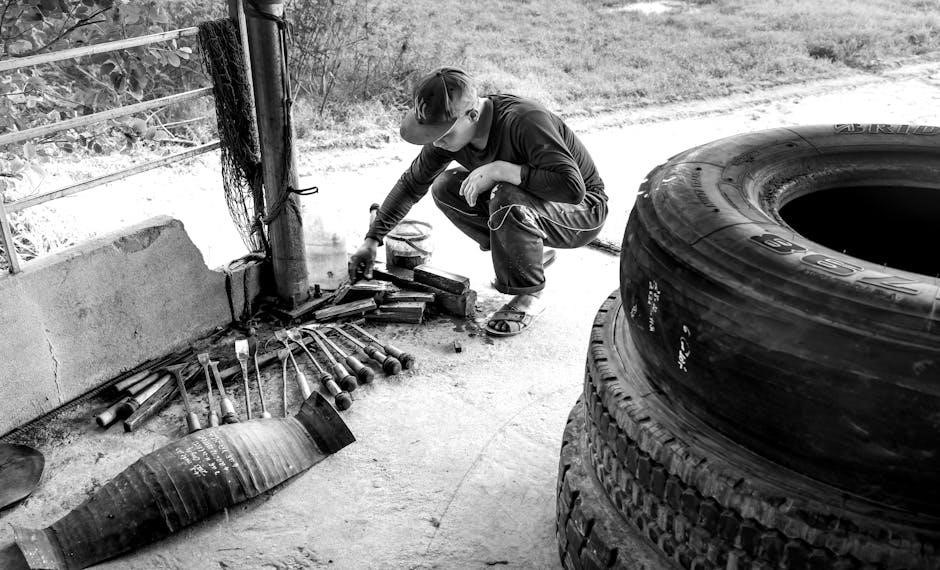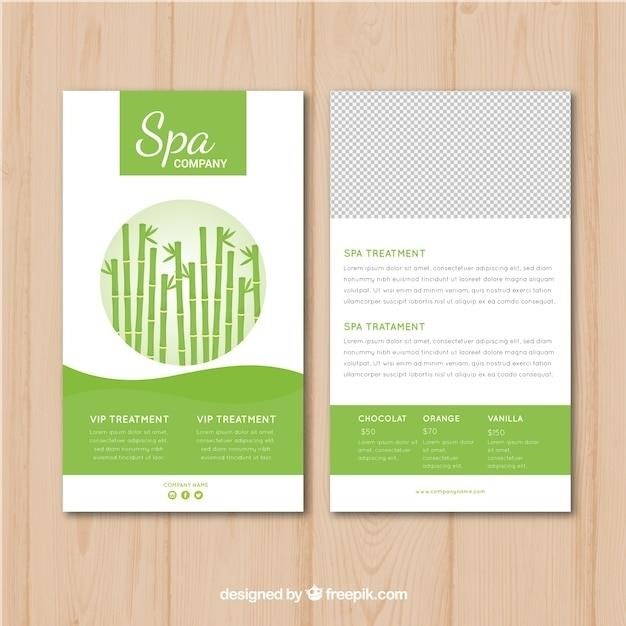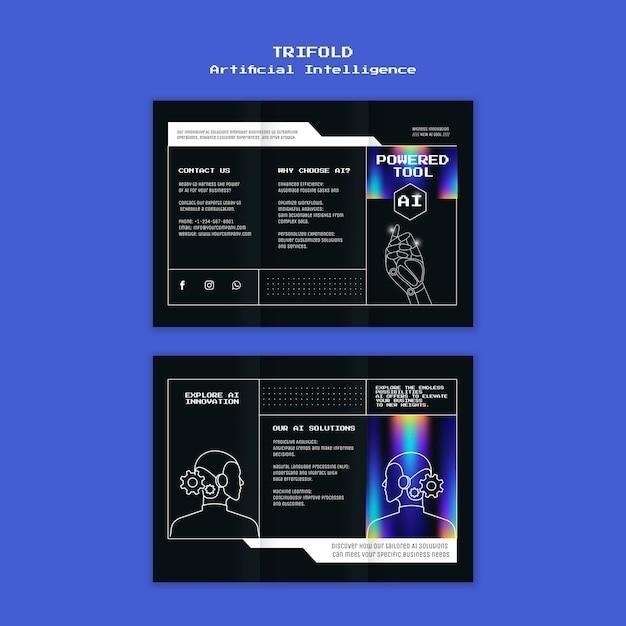This manual provides essential guidance for safe and efficient operation of the Coats Tire Changer, covering key features, maintenance, and troubleshooting to ensure optimal performance and longevity.
1.1 Overview of the Coats Tire Changer
The Coats Tire Changer is a versatile and efficient tool designed for servicing a wide range of automotive and light truck tires. It offers advanced features such as pneumatic wheel clamping, dual-bead roller systems, and leverless mount/demount options for ease of use. Suitable for various tire types, including performance, custom, and aluminum wheels, it ensures precise and safe tire changing. Models like the Coats 50xx Series and 4050A cater to different needs, providing reliable solutions for both standard and specialized applications. The machine is built to handle tubeless and tube-type tires, making it a comprehensive solution for professional and amateur users alike.
1.2 Importance of Reading the Manual
Reading the Coats Tire Changer manual is crucial for understanding proper operation, safety guidelines, and maintenance procedures. It ensures users are aware of potential hazards and can operate the machine safely. The manual provides detailed instructions for troubleshooting common issues and maximizing the equipment’s performance. By following the guidelines, users can prevent accidents, extend the machine’s lifespan, and ensure efficient tire servicing. It is essential to keep the manual readily accessible for quick reference during operation, maintenance, or repairs, making it an indispensable resource for both novice and experienced operators.

Safety Precautions and Warnings
Adhering to safety guidelines is critical to prevent accidents and ensure proper operation. Always inspect tires for damage, follow explosion hazard precautions, and keep the area clear of debris. Proper training and adherence to manual instructions are essential to minimize risks and maintain a safe working environment while using the Coats Tire Changer.
2.1 General Safety Guidelines
Always follow safety guidelines to prevent accidents and ensure safe operation. Inspect tires for damage before use, wear protective gear, and ensure proper ventilation. Keep loose clothing and long hair tied back, and avoid jewelry that could get caught. Never overinflate tires beyond recommended levels, as this can lead to explosions. Ensure the tire changer is on a level surface and securely anchored. Regularly inspect the machine for wear and tear, and address any issues promptly. Proper training is essential for operators to understand risks and procedures. Negligence can result in serious injury or equipment damage, so adherence to these guidelines is crucial.
2.2 Explosion Hazard and Tire Safety
The Coats Tire Changer is designed to handle tire changes safely, but explosion hazards exist if proper precautions are not taken. Always inspect tires for damage, cracks, or wear before mounting. Never inflate tires beyond the recommended pressure, as overinflation can lead to catastrophic failure. Ensure proper bead seating and sealing to prevent sudden tire bursts. Use caution with high-pressure or large-diameter tires, as they pose higher risks. Keep the work area well-ventilated and free from heat sources or sparks. Always follow the manufacturer’s guidelines for specific tire types, including tubeless and run-flat tires, to minimize explosion risks during the changing process.
2.3 Emergency Procedures
In case of an explosion or tire failure, immediately evacuate the area and shut off the machine’s power supply. Call emergency services if injuries occur. Administer first aid as needed and ensure the area is ventilated. Inspect the machine and surrounding equipment for damage. Do not attempt to operate the tire changer until it has been thoroughly checked and cleared by a professional. Review safety protocols and procedures to prevent future incidents. Always prioritize operator safety and adhere to the guidelines outlined in this manual for handling emergencies effectively. Regular training on emergency procedures is essential for all operators.

Machine Overview and Components
The Coats Tire Changer is designed for efficient and safe tire servicing, featuring advanced components like pneumatic clamping systems and dual-bead rollers for optimal performance across various tire types.
3.1 Key Features of the Coats Tire Changer
The Coats Tire Changer is equipped with a pneumatic wheel clamping system for faster and easier operation compared to manual systems. It features a dual-bead roller system, designed to handle various tire types, including performance, custom, and aluminum wheels. The machine is compatible with single-piece automotive and light truck tire/wheel assemblies, offering versatility for different vehicle applications. Additionally, it includes advanced components like a leverless mount/demount head, reducing the need for manual tools and enhancing efficiency. These features ensure safe, efficient, and reliable tire changing processes for a wide range of tires and wheels.
3.2 Parts Identification and Description
The Coats Tire Changer consists of key components such as the pneumatic wheel clamping system, dual-bead roller system, and leverless mount/demount head. The control panel manages machine operations, while the inflation pedal controls air flow for bead seating and tire inflation. Essential parts include the clamping jaws, bead seating roller, and tire inflator. Each component is designed for durability and precision, ensuring efficient tire changing. Refer to the parts breakdown in the manual for detailed descriptions and exploded views to aid in identification and maintenance.
3.3 Technical Specifications
The Coats Tire Changer models, such as the 50xx Series and 4050A, feature specifications tailored for versatility and performance. The 50xx Series supports single-piece automotive and light truck tires, with compatibility for custom and aluminum wheels. The 4050A model weighs approximately 726 lbs and operates on 220VAC, 1ph, 60Hz power. It includes a pneumatic wheel clamping system and dual-bead roller for efficient tire handling. Technical details ensure safe operation, with features like explosion hazard protection and precise inflation controls. Refer to the manual for model-specific dimensions, weight, and electrical requirements to ensure proper installation and use.

Operating Instructions
Follow detailed steps for inflation, deflation, and bead sealing. Always inspect tires and wheels for damage before mounting. Ensure all safety guidelines are strictly followed.
4.1 Basic Operations and Controls
Mastering basic operations ensures efficient and safe use of the Coats Tire Changer. Start by powering on the machine and ensuring all controls are accessible. The inflation pedal operates in three positions: position 1 for initial inflation, position 2 to begin air flow, and position 3 for final sealing. Use the bead roller to securely seat the tire bead. Always inspect the tire and wheel for damage before mounting. Properly lubricate beads to prevent damage and ensure a tight seal. Follow the sequence outlined in the manual to avoid errors. Familiarize yourself with emergency stop mechanisms and safety features.
- Ensure tire is correctly positioned on the changer.
- Use controls smoothly to avoid sudden movements.
- Refer to the manual for specific pedal functions.
4.2 Bead Sealing and Bead Seating Procedures

Bead sealing and seating are critical steps for ensuring a secure tire fitment. Begin by deflating the tire completely and inspecting for damage. Apply the recommended lubricant to both beads to prevent damage and ensure a proper seal. Use the bead roller to gently press the bead onto the rim, working from one side to the other. Inflate the tire gradually, monitoring pressure to avoid over-inflation. If the bead does not seat properly, deflate and re-lubricate before retrying. Always follow the manufacturer’s guidelines for specific tire types and sizes. Proper techniques prevent damage and ensure safety.
- Deflate the tire fully before starting.
- Inspect for damage or wear.
- Apply lubricant evenly to both beads.
4.3 Tire Inflation and Deflation Processes
Proper tire inflation and deflation are essential for safe and efficient operation. To deflate, ensure the tire is completely flat before inspection. For inflation, attach the valve stem and slowly pressurize the tire, monitoring the gauge. Use the inflation pedal: press to position 2 to start airflow, then to position 3 for final seating. Avoid over-inflation, as it can damage the tire or rim. Always follow the manufacturer’s recommended pressure limits. If issues arise, deflate, inspect, and reattempt the process. Regular checks ensure accurate pressure readings and prevent potential hazards during tire changes.
- Deflate tires fully before inspection.
- Monitor pressure during inflation.
- Avoid exceeding recommended pressure.

Maintenance and Care
Regular maintenance ensures longevity and efficiency. Check hydraulic systems, lubricate moving parts, and clean the machine regularly. Refer to the maintenance section for detailed procedures.
5.1 Daily Maintenance Tips
Regular daily maintenance ensures optimal performance and longevity of your Coats Tire Changer. Inspect tire beads for wear and tear, and clean the machine thoroughly after each use. Lubricate all moving parts, such as rollers and hinges, to prevent friction and wear. Check air and hydraulic systems for leaks or damage. Ensure proper tire pressure settings are followed to avoid over-inflation or under-inflation. Store the machine in a dry, clean environment to prevent rust and corrosion. Always refer to the manual for specific lubrication recommendations and maintenance schedules.
5.2 Advanced Maintenance Procedures
Advanced maintenance procedures for the Coats Tire Changer involve detailed inspections and replacements. Check hydraulic fluid levels and replace seals if leaks are detected. Inspect electrical connections for wear or corrosion and ensure proper tightening. Replace worn or damaged rollers and clamps to maintain precise wheel handling. Clean and lubricate the bead seating and inflation systems regularly. Perform a full calibration of the machine every 6 months to ensure accuracy. Refer to the manual for specific part replacement guidelines and schedules to maintain optimal performance and prevent downtime. Always use genuine Coats replacement parts for reliability and safety.
5.3 Lubrication and Care for Moving Parts
Regular lubrication of moving parts is crucial for the Coats Tire Changer’s smooth operation. Apply high-quality grease to the bead rollers, clamps, and hinges every 30 days or after 50 tire changes. Use a silicone-based spray on pivot points and sliding surfaces monthly. Inspect and clean all lubricated areas before applying grease to prevent contamination. Replace any worn or damaged seals or bushings promptly. Proper care ensures reduced friction, extends equipment life, and maintains efficiency. Always follow the manufacturer’s recommendations for lubricants to avoid damage to the machine’s components and ensure optimal performance throughout its operational life.

Troubleshooting Common Issues
Identify and address common problems like bead seating failure, inflation errors, or machine malfunction by referring to the manual’s troubleshooting guide for quick, effective solutions.
6.1 Common Problems and Solutions
Common issues with the Coats Tire Changer include bead seating failure, inflation errors, or machine malfunction. For bead seating problems, ensure proper lubrication and inspect for damage; If the tire won’t inflate, check valve connections and pressure settings. Malfunctions may require resetting the system or replacing worn parts. Always refer to the manual for specific troubleshooting steps and solutions. Regular maintenance, such as lubricating moving parts, can prevent many issues. If problems persist, contact authorized service personnel for assistance. Proper care ensures optimal performance and extends the life of the machine.
6.2 Bead Seal and Bead Seat Troubleshooting
Bead sealing and seating issues often arise from improper lubrication or damaged beads. Inspect the tire and wheel for debris or wear. Ensure the bead roller is functioning correctly and adjust as needed. If the bead doesn’t seat, deflate the tire completely, relubricate, and retry. Misalignment of the tire changer’s head can also cause problems, so check and adjust the machine’s alignment. Always follow the manual’s procedures for bead operations and refer to the troubleshooting guide for specific solutions. Proper techniques prevent damage and ensure a secure seal for safe tire inflation.
6.3 Inflation and Deflation Issues
Common issues during inflation and deflation include slow or uneven pressure changes, leaks, or failure to reach the desired pressure. Ensure the tire valve is clean and free from debris. Check the inflation hose and connections for damage or blockages. If under-inflation occurs, verify the air supply pressure and ensure the pedal is fully engaged. For deflation issues, inspect the valve core and gauge accuracy. Always follow the manufacturer’s guidelines for maximum pressure limits. If problems persist, consult the troubleshooting section or contact a professional. Regular maintenance of the air system and components can prevent these issues and ensure reliable operation.

Coats Tire Changer Models
Coats offers a range of tire changer models, including the 50xx Series, 4050A, and other specialized variations, designed to handle diverse tire types and applications efficiently.
7.1 Coats 50xx Series Tire Changer
The Coats 50xx Series Tire Changer is a versatile and reliable solution for servicing single-piece automotive and light truck tire/wheel assemblies. Designed to handle a wide range of tire types, including performance, custom, and aluminum wheels, this series offers efficient tire-changing capabilities. Key features include advanced bead-sealing technology and a robust construction to ensure durability. The 50xx Series is part of Coats’ extensive lineup, catering to various automotive needs with precision and ease. Its compatibility with different tire and wheel configurations makes it a popular choice among professionals and enthusiasts alike.
7.2 Coats 4050A Tire Changer
The Coats 4050A Tire Changer is a high-performance model designed for servicing single-piece automotive and most light truck tire/wheel assemblies. It excels with custom and special wheels, including tube-type tires, offering versatility for various applications. The 4050A features advanced inflation and deflation controls, ensuring precise handling of different tire types. Its robust design and user-friendly interface make it a preferred choice for workshops and garages. The model emphasizes safety, with clear guidelines for bead sealing and seating procedures, ensuring efficient and secure tire changes. Regular updates and maintenance tips are provided to maximize its performance and longevity.
7.3 Other Models and Variations
Beyond the 50xx Series and 4050A, Coats offers additional models tailored for specific needs. The 70X Leverless Tire Changer eliminates manual tools with its innovative design, while the ProGuard Plus Leverless model is built for advanced applications. Other variations include the HIT 5000H Truck Tire Changer and the TTC 700, designed for heavy-duty and light commercial vehicles. These models cater to diverse requirements, from automotive to large truck tires, ensuring compatibility and efficiency. Each variation is engineered with unique features, such as pneumatic clamping systems or dual-bead rollers, to enhance performance and simplify tire servicing across various industries.

Accessories and Additional Equipment
Coats offers a range of accessories, including compatible wheels, optional tools, and additional equipment, to enhance performance and optimize the use of your tire changer.
8.1 Compatible Wheels and Tires
The Coats Tire Changer is designed to work with a wide range of wheels and tires, including automotive, light truck, and custom applications. It supports single-piece rims and tube-type tires, ensuring compatibility with various vehicle types. The machine is versatile, accommodating performance, aluminum, and special wheels, making it suitable for diverse tire servicing needs. Proper wheel and tire matching is essential for safe operation, and the manual provides guidelines for selecting the right components. Always refer to the manufacturer’s specifications for optimal performance and safety.
8.2 Optional Accessories for Enhanced Performance
Optional accessories for the Coats Tire Changer enhance functionality and efficiency. These include upgraded bead rollers, pneumatic wheel clamping systems, and leverless mount/demount heads. Accessories like the dual-bead roller system improve bead seating and reduce effort. Additional tools, such as wheel clamps and inflation hoses, ensure compatibility with various tire and wheel configurations. Leverless systems eliminate manual tire tools, streamlining the process. These accessories are designed to minimize wheel damage and optimize performance, making the Coats Tire Changer adaptable to diverse tire servicing needs while maintaining safety and precision.
8.3 Recommended Tools and Supplies
For optimal performance, use recommended tools and supplies with your Coats Tire Changer. Essential items include tire lubricants for bead seating, pressure gauges, and centering tools to ensure proper wheel alignment. Additional supplies like protective gloves and safety goggles enhance workplace safety. Regularly inspect and maintain these tools to prevent damage to tires and wheels. Keep a supply of compatible inflation hoses and adapters on hand. Refer to the manual for specific recommendations tailored to your model. Proper tools and supplies ensure efficient, safe, and professional tire servicing, aligning with the Coats Tire Changer’s design for precision and durability.

Installation and Setup
Proper installation ensures safe and efficient operation. Bolt the unit securely to the floor, connect air and hydraulic systems, and perform initial testing to confirm functionality;
9.1 Step-by-Step Installation Guide
Ensure the area is clean and level before starting. Securely bolt the Coats Tire Changer to the floor using the provided slotted holes for stability. Connect the air and hydraulic systems according to the specifications in the manual. Perform a thorough inspection of all hoses and connections to prevent leaks. Power up the unit and run initial tests to verify proper function. Refer to the manual for specific pressure settings and calibration requirements. If unsure, contact a certified technician or Coats support for assistance. Proper installation is critical for safe and efficient operation.
- Bolt the unit to the floor using slotted holes.
- Connect air and hydraulic systems carefully.
- Inspect all connections for leaks.
- Test the unit to ensure proper functionality.
9.2 Connecting Air and Hydraulic Systems
Ensure the area is clean and clear before connecting the systems. Identify the correct ports for air and hydraulic hoses and attach them securely to prevent leaks. Refer to the manual for recommended pressure settings and tighten connections to specified torque values. Conduct a low-pressure test to check for leaks before full operation. Always follow safety guidelines and manufacturer instructions to avoid potential hazards. Proper connection is crucial for safe and efficient tire changing operations.
9.3 Initial Testing and Calibration
Power up the machine and conduct a thorough system check to ensure all components function correctly. Inspect air and hydraulic lines for leaks and test pressure levels according to the manual. Calibrate the tire changer by following the step-by-step instructions provided, ensuring accurate performance. Perform a trial run with a practice tire to verify proper operation. Always refer to safety guidelines and manufacturer recommendations during testing. Proper calibration is essential for maintaining precision and preventing potential issues during tire-changing operations.
Regular maintenance and adherence to safety guidelines ensure optimal performance and longevity of your Coats Tire Changer. Stay updated with manufacturer recommendations for enhanced functionality and safety.
10.1 Maximizing Performance and Longevity
Maximizing performance and longevity of your Coats Tire Changer involves regular maintenance, proper lubrication, and adherence to safety guidelines. Daily checks of hydraulic systems and moving parts ensure smooth operation. Always follow recommended tire pressure specifications to avoid damage. Proper storage and handling of wheels and tires prevent wear and tear. Regularly update software and firmware to access new features and improvements. By following these steps, you can extend the life of your tire changer and maintain its efficiency for years to come. Consistent care ensures reliable performance across various tire types and sizes.
10.2 Importance of Regular Updates and Service
Regular updates and service are crucial for maintaining the optimal performance of your Coats Tire Changer. Software updates often include improvements to operational efficiency and safety features, ensuring compatibility with the latest tire technologies. Scheduled maintenance, such as lubrication of moving parts and inspection of hydraulic components, prevents unexpected downtime. Additionally, calibrated systems ensure accurate tire pressure readings, which are essential for safety and proper tire inflation. By prioritizing regular service, you can avoid costly repairs, enhance reliability, and extend the lifespan of your equipment. Stay updated to keep your Coats Tire Changer functioning at its best.



